#exakta varex IIa
Explore tagged Tumblr posts
Video
FILM - Red Lion Hotel by Jonathan Burley Via Flickr: Inside the Red Lion Hotel on the marketplace at Spalding. Exakta Varex IIa (1960) SLR camera Zeiss Pancolar 50 mm f/2 lens Fuji Superia Xtra 400 film Lab develop & scan 000015500036_0001
#Red Lion Hotel#Spalding#pub#bar#Exakta Varex IIa#Zeiss Pancolar 50 mm f/2#Fuji Superia Xtra 400#film#flickr
0 notes
Text

Christopher Williams
Fig. 7: Turning the exposure counter knob Exakta Varex IIa 35 mm film SLR camera Manufactured by Ihagee Kamerawerk Steenbergen & Co, Dresden, German Democratic Republic Body serial no. 979625 (Production period: 1960 - 1963) Carl Zeiss Jena Tessar 50mm f/2.8 lens Manufactured by VEB Carl Zeiss Jena, Jena, German Democratic Republic Serial no. 8034351 (Production period: 1967 - 1970) Model: Christoph Boland Studio Thomas Borho, Oberkasseler Str. 39, Düsseldorf, Germany June 21st, 2012, 2012
2 notes
·
View notes
Text
I have several Exakta Exa cameras in my collection but this Varex IIa is the first of the ‘top flight’ Exakta models I’ve acquired. The model was produced in a variety of different styles and variations over quite a long time period and the example I own is one of the later variants.
Exakta Varex IIa 35mm slr – front view
Exakta Varex IIa 35mm slr – side view showing flash sync
Exakta Varex IIa 35mm slr – side view showing shutter release
Exakta Varex IIa 35mm slr – back of camera
Exakta Varex IIa 35mm slr – base of camera
Exakta Varex IIa 35mm slr – rewind crank and film cutter
Exakta Varex IIa 35mm slr – film chamber
Exakta Varex IIa 35mm slr – Film Cutter
Exakta Varex IIa 35mm slr – Shutter blinds crinkly
Exakta Varex IIa 35mm slr – Top of camera
Exakta Varex IIa 35mm slr – Fast speed dial, frame counter and film advance
Exakta Varex IIa 35mm slr – Slow speed dial
Exakta Varex IIa 35mm slr – Shutter release with guard
Exakta Varex IIa 35mm slr – Bayonet mount
Exakta Varex IIa 35mm slr – Finder removed
Exakta Varex IIa 35mm slr – Waist Level Finder fitted
Exakta Varex IIa 35mm slr – Waist Level Finder view
Exakta Varex IIa 35mm slr – Waist Level Finder magnifier
Exakta Varex IIa 35mm slr – Front view with waist level finder fitted
Exakta Varex IIa 35mm slr – Waist level finder fitted
Exakta Varex IIa 35mm slr – Carl Zeiss Jena Pancolar 50mm f/2
These pictures can be viewed full size here.
My Camera
I bought this camera simply because I’d bought several Exa models and had been impressed with the build quality and style of those cameras. Since the Exa series was a ‘cut down’ cheap model, I thought I’d like to own one of the proper Exakta models and so I bought this, along with the attached Carl Zeiss Jena Pancolar 50mm f/2 lens, for about £16.
The camera was advertised on eBay as being ‘fully functional’ and when it turned up a couple of days after the end of the auction I confirmed that, generally speaking, that is true. All the shutter speeds are about right, including the slow speeds and the self timer, and the shutter blinds work so as far as I can see without running a film through the camera everything seems right. Another plus is that the mirror is quite good with only a few spots and some dust which will hopefully come off with some careful cleaning.
The viewfinder fitted was an eye level finder which has some dirt and minor scratches, but I also have a waist level finder fitted to my Exa 1 which also fits this camera, so that gives me a more complete set. Since the focusing screen is easily detachable on the Exakta finders, I should be able to clean the eye level finder up.
On the negative side however, the shutter blinds are quite wrinkly and old and although they seem to be light tight, they really should be replaced. Also I think I will probably strip the camera down and clean up the mechanism to remove the old oil and grease which any camera of 60 odd years old will have accumulated.
The cosmetic condition of the camera is very good considering its age – most of the paintwork is intact, the chrome work looks good and the leathers just have a few white spots around the flash sync sockets. With a bit of cleaning and lubrication this camera should be as good as new.
Exakta Varex IIa Description
The Exakta series was a stylish and sophisticated camera system which was also one of the earliest 35mm slr systems made. The Varex IIa model was made for a number of years and had a number of different variants, but most of the changes were cosmetic rather than mechanical. The version I have is one of the later models where the Exakta name plate is a printed black plate in front of the viewfinder.
The basic camera design is a 35mm slr camera with a wide range of shutter speeds, comprehensive flash sync options, a replaceable viewfinder system, replaceable lenses and a distinctive body shape. It is a heavy camera, and feels well made and solid and had a very large number of accessories and lenses made for it over the 40 or so years that the cameras were made.
This slideshow requires JavaScript.
The viewfinder is a replaceable system which allows both eye level and waist level finder to be fitted. There is a small lever on the front of the camera which releases the viewfinder so it can be pulled out of the camera body. As well as the standard viewfinders, there were also finders made which included a light meter built into the top although I currently don’t own one of those models.
The viewfinders are a design which easily allows the focus screen to be removed for cleaning and different focus screens were available which included split image, plain ground glass etc.
The shutter speed setting arrangement, is one of the most sophisticated I’ve seen on a mechanical camera. There are two speed dials, a fast setting dial on the left hand side, which sets the speeds of 1/1000 to 1/25sec and bulb and time settings. Then on the other side, there is a large dial which controls shutter speeds of 1/5, 1/2, 1sec, 2sec, 4sec, 6sec, 8sec, 10sec & 12sec (yes 12 seconds shutter time). Also on this dial is the self timer dial which allows you to dial in shutter delays and these can be applied to any of the pre set times. It is an impressive arrangement of shutter times for a camera which was first made in the 1930s!
One warning about the shutter speed setting – make sure the shutter is cocked before setting the speed. It is possible to damage the mechanism if it is adjusted before the shutter is cocked. Since the mirror is a non-return design it’s probably best to get into a habit of winding the film, composing the picture, setting the exposure and then release the shutter.
Back to the controls; On the same side as the fast shutter speed dial is the film advance lever and the frame counter. Both of these are a bit odd in their operation. The film advance lever has a very long throw of about 300 deg which is quite difficult to do in a hurry. Also, being on the left hand side of the camera means that for anyone who is right handed, it seems to feel a bit odd. The frame counter, which is built into the film advance pillar, is odd because the counter increments when the shutter is fired rather than when the film is advanced.
Talking of the film transport, here is another oddity about the Exakta. There is a removable take up spool in the camera which can be removed and replaced with a standard 35mm film cassette. This allow you to wind film out of a full cassette and into an empty cassette – nothing spectacularly interesting there but what is interesting is that there is a cutter built into the camera which allows you to cut the film and remove the partially exposed film to be developed! On the bottom of the camera, next to the film rewind spool is a small knurled knob, and when it is undone and the attached shaft withdrawn it pulls a blade down the film cutting it just next to the unexposed film cassette. I don’t know of any other camera which had this feature.
For flash sync the Varex IIa supplies three different sockets to provide sync for flash bulbs (M & F) or electronic flash (X) and these are fitted on the front panel of the camera. Also fitted to the front panel is the shutter release button, with a swing over cap which acts as a shutter lock. The reason the release is fitted to the front panel is so that a PAD (pressure activated diaphragm) lens can be used which will close the lens aperture before the shutter is closed.
The lens suppled with the camera is a Carl Zeiss Jena Pancolar 50mm f/2 lens which has quite a good reputation for sharpness and colour definition. The lens has a slight problem with the shutter which is a bit reluctant to both stop down and open up, which is probably due to oil contamination and should hopefully be reasonably easy to fix.
The Pancolar was one of the many lens units suppled with the camera, but the Exakta bayonet was a very popular lens mount and literally thousands of lenses were made including some very high quality units. As I build up my Exakta collection I hope to add some more of the classic lenses as well as some other body designs.
The next move for this camera is a strip down and clean up of the mechanism and check the condition of the shutter blinds to see if they are ok or if they need to be replaced.
Exakta Varex IIa Specification
Exakta Varex IIa 35mm slr camera
Extensive mechanical shutter times of 12sec to 1/1000sec
Self timer
Replaceable viewfinder
Exakta bayonet lens mount
Non return mirror design
Film cutter
Film type reminder
Table top stand built into camera
Removable back door
Removable take up spool which can be replaced with empty cassette
Flash sync sockets for type X, M and F flash
Front mounted shutter release with lock
Cable release thread in shutter release
Manually settable frame counter
Long throw film advance
Fitted with 50mm f/2 Carl Zeiss Jena Pancolar lens
Body Ser No: 993666
Lens Ser No: 5822826
Manual available on-line here
Exakta Varex IIa 35mm slr camera I have several Exakta Exa cameras in my collection but this Varex IIa is the first of the 'top flight' Exakta models I've acquired.
#35mm#exakta varex IIa#exchangeable lens#film#photography#replaceable focusing screen#replaceable viewfinder#vintage camera
0 notes
Text
5 Frames with the Exakta Varex IIa - By Glenn Bech
5 Frames with the Exakta Varex IIa – By Glenn Bech
My analog photography obsession snowballed quickly from a Pentax K1000 flea market impulse buy. Before I knew it, I had a budding camera collection and was part of a darkroom community. The gear aspect of photography can undoubtedly take a life of its own. And I am no stranger to GAS, gear acquisition syndrome. As of late, I mostly shoot medium format with my Hasselblad 500CM (I’ll sell body…

View On WordPress
0 notes
Text
LILLIES OF THE VALLEY
Yesterday I was practicing focus with a 60 year old camera, an Exakta Varex IIa. This is a beautiful looking camera but it's rather quirky and takes a bit of getting used to. I’ve been struggling to get sharp focus with the waist level finder.
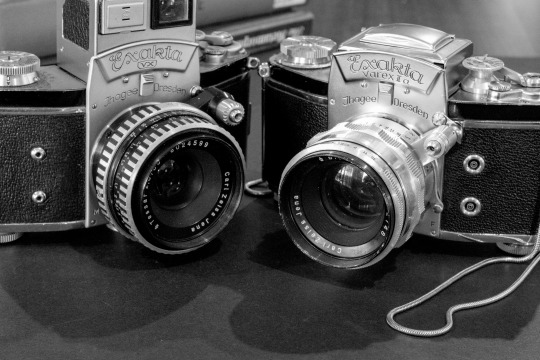
I threw a budget film in it and played around with lighting, off camera flash and photographing my new favourite subject - dying flowers. I learned how to meter for off camera flash - yay thanks JD - and also used reflectors, but for the most part, the shoot was pretty simple.
I soon found that the problem with focus is not just my dodgy eyesight - the lens is soft as hell. I was using a Biotar 58mm F2 which has an excellent reputation as a fine lens, with sharp focus in the centre and lovely soft bokeh at the edges. While I was getting sharp areas, they were not in the places I thought I was putting them :) . The other lens I have is a Tessar 50mm F2.8 which is more conventional than the Biotar and behaved a little better.
After struggling with the waist level finder for half the roll, I switched to a prism finder with split screen focus and had much less trouble.
For some reason I decided to develop the roll in Rodinal, which I had to dig it out of the back of the cupboard cause I hadn’t used it in ages. Maybe I was hoping it would help with sharpness, cause that's a Rodinal trait, but I forgot that Rodinal can add lots of grain as well. My budget roll of Fomapan 400 comes with plenty of grain on it’s own - a brave combination.
What I got was rather interesting. Soft, grainy, high contrast images. Not what I was hoping for (sharp, focused images with lovely bokeh) but I actually really like these. I don’t think I’ll be using a Exakta as my goto camera, but when I want to play with something arty, I know exactly where to go.
I call this series Lillies of the Valley.
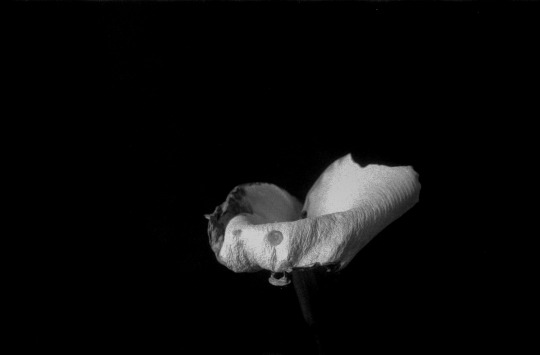
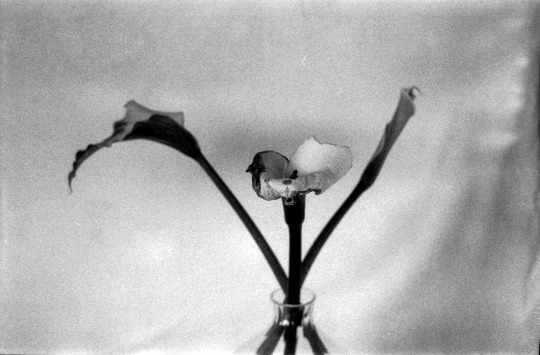
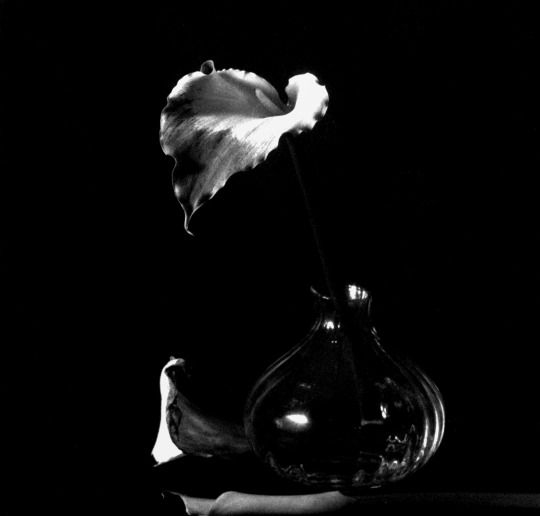
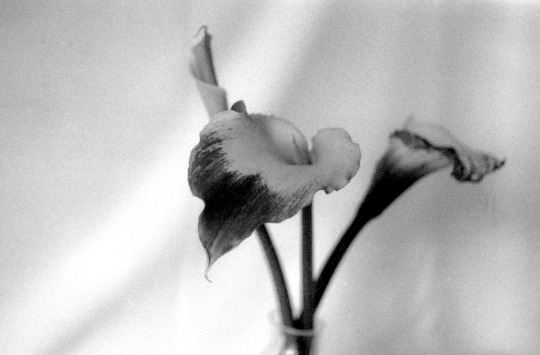

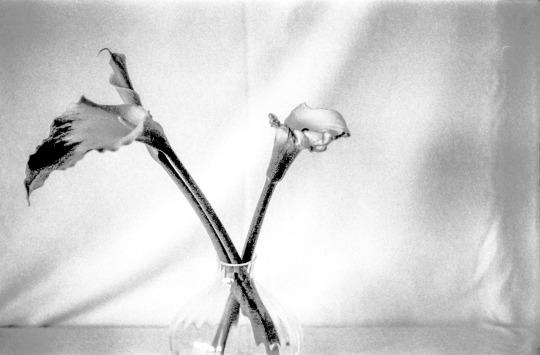
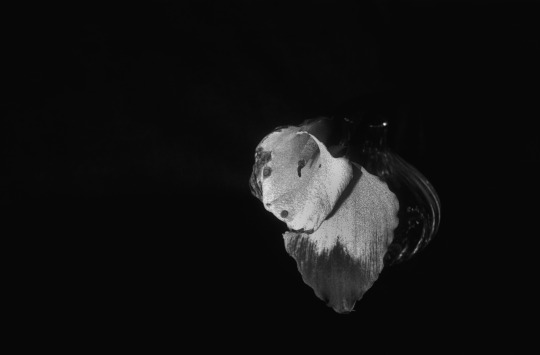
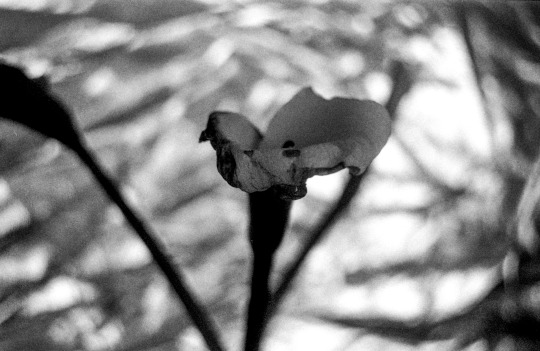

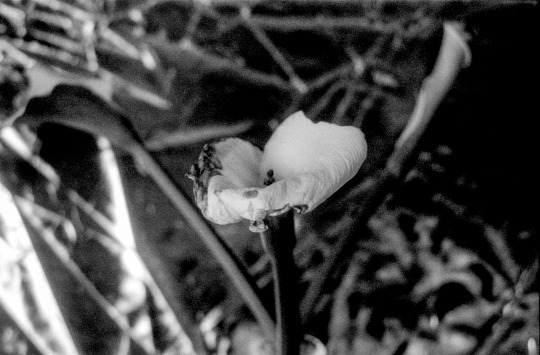
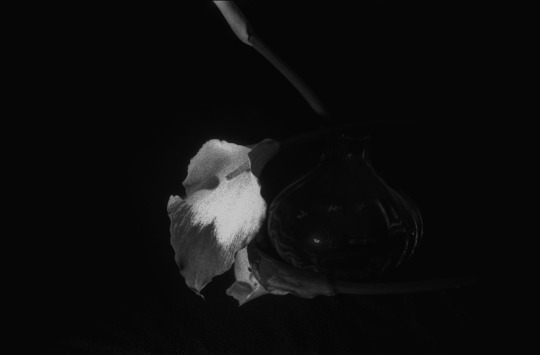
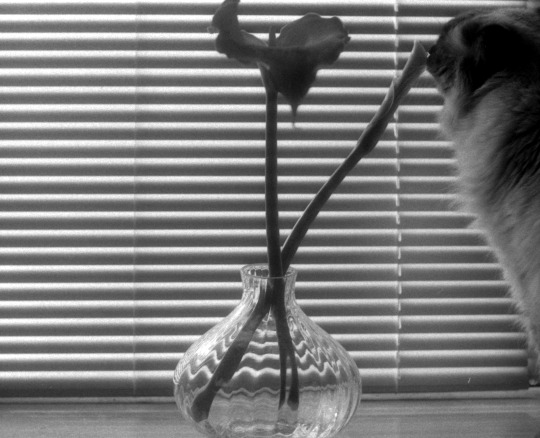
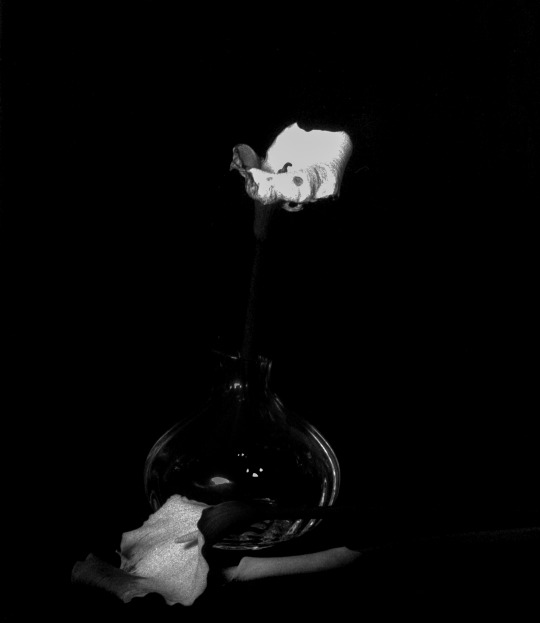
0 notes
Video
exakta by gaby jeter
15 notes
·
View notes
Photo

exakta by gaby jeter
40 notes
·
View notes
Text
A couple of days ago I bought an Exakta Varex IIb body to go with my Exakta Varex IIa which I bought a few weeks ago. This camera was bought from eBay for only £10 because it needed a repair, so my first job when I received it was to get the shutter unit out in order to see what was wrong with it.
Exakta Varex IIb Strip Down – remove top of film advance
Exakta Varex IIb Strip Down – undo the revealed nut
Exakta Varex IIb Strip Down – lift off the advance lever
Exakta Varex IIb Strip Down – unscrew middle of speed control
Exakta Varex IIb Strip Down – removed spring and washer
Exakta Varex IIb Strip Down – lift off speed control
Exakta Varex IIb Strip Down – unscrew retaining screws and lift off cover
Exakta Varex IIb Strip Down – unscrew top of slow speed control
Exakta Varex IIb Strip Down – unscrew revealed nut
Exakta Varex IIb Strip Down – removed washer
Exakta Varex IIb Strip Down – remove disc
Exakta Varex IIb Strip Down – remove spring washer
Exakta Varex IIb Strip Down – remove large spring
Exakta Varex IIb Strip Down – remove screws and lift off cover
Exakta Varex IIb Strip Down – cover removed from slow speed side
Exakta Varex IIb Strip Down – remove mount screws and lift off mount
Exakta Varex IIb Strip Down – remove three revealed screws
Exakta Varex IIb Strip Down – remove front decor plate
Exakta Varex IIb Strip Down – remove screw in film chamber
Exakta Varex IIb Strip Down – remove screws in back
Exakta Varex IIb Strip Down – remove screw holding cover
Exakta Varex IIb Strip Down – remove screw holding cover
Exakta Varex IIb Strip Down – remove screws under cover and middle drive cog
Exakta Varex IIb Strip Down – drive gear removed
Exakta Varex IIb Strip Down – cover and internal felt washer off
Exakta Varex IIb Strip Down – shutter extracted from case
Exakta Varex IIb Strip Down – detail under cover
Exakta Varex IIb Strip Down – film advance component with unwound spring
Exakta Varex IIb Strip Down – film advance needs cleaning
Exakta Varex IIb Strip Down – detail under cover
Exakta Varex IIb Strip Down – film advance and flash contacts
The pictures above show the steps necessary to get the shutter out of the case. One big advantage of working on the Exakta series is the way the shutter can be removed from the camera case and be fully functional which makes it easier to see what needs to be done to get the camera working.
As it happens, although the film advance was completely locked when I initially tried it, when the shutter was out of the camera I could get it to work, so it seems all that is needed in this case is some cleaning, lubrication and general TLC to hopefully restore it to it’s former glory.
A tip which you may find useful if you need to do this at any time is that the fast speed setting knob will also double as a film advance when the shutter is out of the camera and the film advance lever is off – I found this quite useful to cock and fire the shutter.
Exakta Varex IIb strip down A couple of days ago I bought an Exakta Varex IIb body to go with my…
0 notes
Photo

New film camera! This is an absolutely flawless 1959 Exakta Varex IIa with a P.Angenieux Retrofocus 24mm lens. The body is the same one that Jimmy Stewart used in Hitchcock's "Rear Window"
0 notes
Photo

exakta by Gaby J Photography on Flickr.
5 notes
·
View notes
Photo

exakta on Flickr.
14 notes
·
View notes
Photo

exakta by Gaby J Photography on Flickr.
33 notes
·
View notes
Text
A few weeks ago I bought an Exakta Varex IIa 35mm slr which came with a Carl Zeiss Jena Pancolar 50mm f/2 lens in Exakta mount. While I’m cleaning and servicing the Exakta camera, I decided to try the lens out on my Fuji X-T1 mirrorless to see how it performs.
Carl Zeiss Jena Pancolar 50mm f/2 on Fuji X-T1 – Spring flowers
Carl Zeiss Jena Pancolar 50mm f/2 on Fuji X-T1 – Bus stop
Carl Zeiss Jena Pancolar 50mm f/2 on Fuji X-T1 – Pallets
Carl Zeiss Jena Pancolar 50mm f/2 on Fuji X-T1 – The Pied Piper
Carl Zeiss Jena Pancolar 50mm f/2 on Fuji X-T1 – Blue bells
Carl Zeiss Jena Pancolar 50mm f/2 on Fuji X-T1 – Blue bells
Carl Zeiss Jena Pancolar 50mm f/2 on Fuji X-T1 – The road to Hertford
Carl Zeiss Jena Pancolar 50mm f/2 on Fuji X-T1 – Background defocus
Carl Zeiss Jena Pancolar 50mm f/2 on Fuji X-T1 – Garden Rabbit
Carl Zeiss Jena Pancolar 50mm f/2 on Fuji X-T1 – Taking the kids to school
Carl Zeiss Jena Pancolar 50mm f/2 on Fuji X-T1 – Coloured flowers
The CZJ Pancolar has a reputation for being an excellent lens and I wondered if this is a well deserved reputation which applies to every example, or if it is actually just a run of the mill lens with a few particularly good copies?
To use the lens on the X-T1 I needed to adapt the lens, and I did this with a simple and cheap adapter purchased from Amazon for only a few pounds. I never see any reason to pay too much for mirrorless lens adapters because they are basically only a hollow tube, so as long as the tolerances are good enough that the lens fits the adapter and the adapter fits the camera they basically can’t go wrong. However, that said, I do make sure I thoroughly clean the adapter before I use it to make sure there are no metal shards or anything similar which could get on to the sensor.
The lens itself has a couple of problems which I will need to fix before I use it on my Exatka. First, the aperture is a bit sluggish to stop down when the auto stop down function is used. This probably means there is grease on the aperture blades and they will need to be cleaned. The other problem is with the focus control which has a couple of of spots where the control tightens up and becomes stiff. This is absolutely typical of lenses of this age and indicates that the grease in the focus helicoid has turned waxy and needs to be cleaned out and replaced with a modern lithium based grease. Both these problems are relatively easy to fix and can be sorted out with a couple of hours work.
To use the Pancolar on my X-T1 I set the aperture to manual mode, which is done by pushing in the release button on the lens and turning it anti-clockwise. When set like this, the aperture blades respond directly to the aperture ring and stop down as soon as the ring is turned.
With the lens attached to the camera, I then use the camera in aperture priority mode by setting the shutter speed to auto, the ISO to auto and (obviously) the focus to manual. The X-T1 then has all the brilliant focus assist options in the viewfinder which help when using this manual focus lens.
The crop factor of the X-T1 means that the lens acts as a 75mm focal length, portrait length lens when attached to the camera, which gives a slightly more cropped picture than when fitted to the Exakta Varex IIa it was bought with. Although I would prefer a wider angle lens to shoot with, the longer length coupled with a widest aperture of f/2 gives the opportunity to create some nice background defocus.
The pictures above are some I took with the Pancolar 50mm on the X-T1 in raw mode, imported into Lightroom and then after a few minor tweaks, exports as jpeg files. How did the lens perform? Well what do you think? I think it has done rather well with good colour definition and pretty good fine detail, but I’d be interested in hearing your opinion. Let me know in the comments section below.
Carl Zeiss Jena Pancolar 50mm f/2 on Fuji X-T1 A few weeks ago I bought an Exakta Varex IIa 35mm slr which came with a Carl Zeiss Jena Pancolar 50mm f/2 lens in Exakta mount.
0 notes
Photo

Überfordert ... by alf sigaro on Flickr.
#Rose#Exakta Varex IIa#Exakta IIa#Exakta#Ihagee#Domiron#Exa#Oreston#meyeroptik#meyeroptikgörlitz#Domiron 2/50#vebfeinoptischeswerkgörlitz
0 notes
Photo

light leaked by komehachi888 on Flickr.
0 notes
